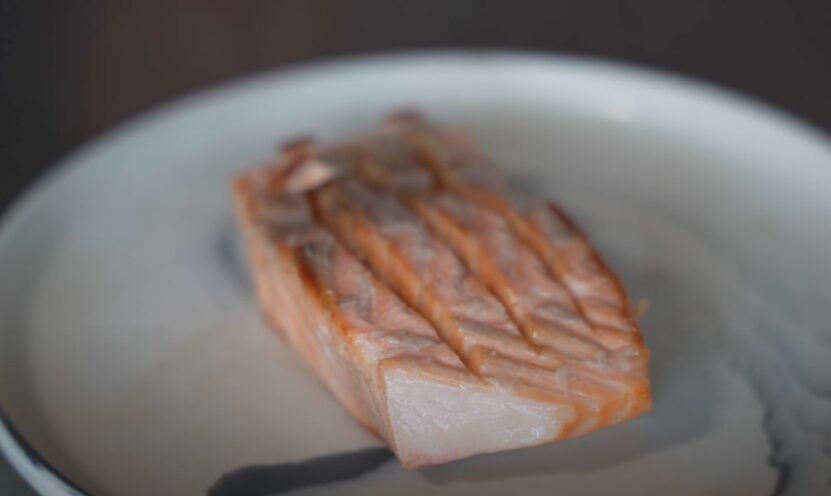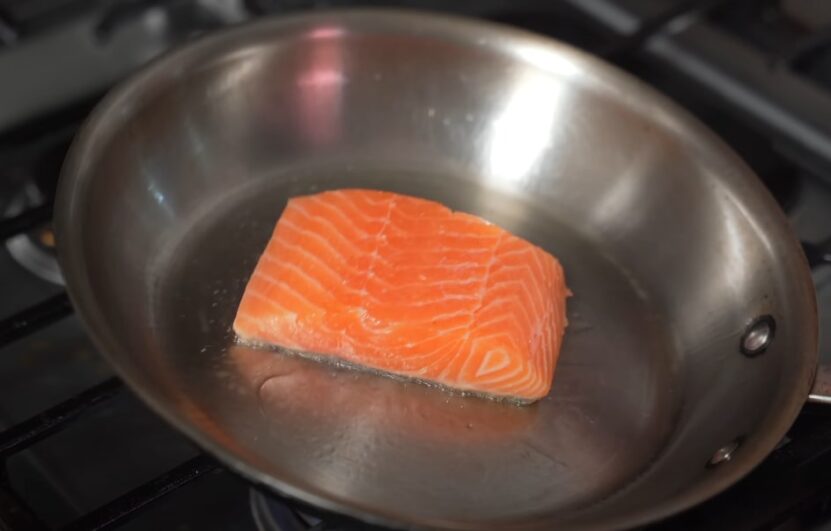Salmon skin is a nutrient-rich part of the fish. It boasts high concentrations of omega-3 fatty acids, vitamin D, and vitamin B. The layer just beneath the skin, the grayish area between the skin and the flesh, is especially abundant in omega-3 fatty acids.
These nutrients are essential for a healthy heart, brain function, and joint health. Regular consumption of these fatty acids can help lower cholesterol, reduce arthritic pain, and prevent heart disease.
So, Is It Safe to Eat This?

The primary concern in determining whether something is edible revolves around its safety. This includes evaluating if the food is non-toxic, free from harmful microorganisms or contaminants, and prepared in a way that makes it safe for consumption. The safety of a food item can vary depending on its source, the way it’s processed, and how it’s cooked.
Nutrition Facts
| Nutrient | Amount per 100g |
|---|---|
| Calories | 208 |
| Protein | 20g |
| Total Fat | 13g |
| Saturated Fat | 3g |
| Cholesterol | 55mg |
| Sodium | 59mg |
| Carbohydrates | 0g |
| Fiber | 0g |
| Sugars | 0g |
Popular Recipes
Now, let’s look at some recipes where this food item is commonly used, highlighting its versatility and nutritional contribution:
- Grilled with Herbs: This method enhances the natural flavors and preserves the nutritional integrity of the food. Grilling with a mix of herbs not only adds flavor but also brings in additional health benefits.
- Baked with Vegetables: Baking is a healthy cooking method that maintains the nutritional profile. Combining it with vegetables adds fiber, vitamins, and minerals to the meal.
- Stir-Fried with Whole Grains: Stir-frying with whole grains like brown rice or quinoa makes for a balanced meal, providing a good mix of protein, healthy fats, and complex carbohydrates.
Health Benefits of Eating Salmon Skin

Salmon skin, often discarded as an unwanted part of the fish, is a hidden gem in terms of nutritional value. This section of the fish is not just a culinary delight; it’s a powerhouse of nutrients, offering several health benefits.
Omega-3 Fatty Acids
One of the most significant benefits of eating salmon skin comes from its rich content of omega-3 fatty acids. These essential fats are not synthesized by the human body, making their dietary inclusion crucial.
Omega-3s, particularly EPA and DHA found in salmon skin, are known for their cardioprotective properties. They help reduce triglycerides, lower blood pressure, and can even reduce the risk of stroke and heart failure.
But the benefits of omega-3s go beyond heart health. They are vital for brain health, playing a crucial role in cognitive function and mental health. DHA, in particular, is a major structural component of the brain and retina, indicating its importance in maintaining brain health and vision.
Studies have linked omega-3 fatty acids to a lower risk of cognitive decline and may even have a role in preventing Alzheimer’s disease.
Skin Hydration and Eye Health
The intake of omega-3 fatty acids from salmon skin also contributes to skin health. These fats help maintain the skin’s lipid barrier, essential in keeping the skin hydrated and plump.
This can lead to a reduction in the signs of aging and may also help in managing conditions like eczema and psoriasis. Moreover, omega-3 fatty acids are beneficial for eye health. Regular consumption can help prevent age-related macular degeneration, a leading cause of vision impairment and blindness.
Great Source of Protein

Salmon skin is also a good source of high-quality protein. Proteins are crucial for building and repairing tissues in the body, and they play a vital role in creating hormones, enzymes, and other essential chemicals. The protein in salmon skin aids in muscle growth and maintenance, making it an excellent food choice for fitness enthusiasts and the elderly.
Vitamins and Minerals
In addition to omega-3s and protein, salmon skin is rich in vitamins and minerals. It contains vitamin D, a nutrient not readily available in many foods. Vitamin D is essential for bone health, as it helps in calcium absorption. It also plays a role in immune function and has been linked to mood regulation and reducing the risk of multiple sclerosis and heart disease.
Vitamin B, particularly B12, found in salmon skin, is crucial for maintaining healthy nerve cells and creating DNA. A deficiency in vitamin B12 can lead to anemia and neurological issues. Salmon skin also contains selenium, a mineral that plays a key role in thyroid hormone metabolism and antioxidant defense systems. It’s important for reproductive health, DNA synthesis, and protecting the body from infection and oxidative damage.
How to Prepare It?

Preparing salmon skin at home can be a simple and rewarding process. Whether you’re a gourmet chef or a home cook, understanding how to handle salmon skin correctly can elevate your culinary creations.
The Process of Removing Salmon Skin
For those who prefer their salmon without the skin, removing it is a straightforward task that requires minimal equipment – a sharp knife and some hot water. Here’s a step-by-step guide:
- Pouring Hot Water: Start by laying the salmon skin-side down. Pouring hot water over the skin helps loosen it from the flesh. This method is particularly useful for those who find it challenging to remove the skin using a knife. The heat from the water softens the skin and the connective tissue, making it easier to peel off.
- Using a Sharp Knife: For a more traditional approach, place the salmon skin-side down on a cutting board. Gently slide a sharp knife between the skin and the flesh, holding the skin with your other hand. Move the knife along the length of the fillet, ensuring that you’re staying close to the skin to minimize wastage of the flesh.
- Preventing Waste: If you’re removing the skin, consider using it in other dishes. Salmon skin can be crisped up in a pan for a crunchy snack or used as an ingredient in various recipes. This approach not only maximizes your use of the fish but also allows you to enjoy the health benefits of salmon skin.
Tips for a Crispy Texture
If you decide to cook the salmon with the skin on, achieving a crispy texture is key to enhancing the dish’s appeal. Here are some tips:
- Dry the Skin: Before cooking, pat the salmon skin dry with paper towels. Moisture is the enemy of crispiness, so it’s essential to remove as much as possible.
- Seasoning: Lightly season the skin with salt, which helps draw out moisture and adds flavor.
- Cooking Technique: Place the salmon skin-side down in a hot pan with a little oil. Press down gently to ensure even contact with the pan. Cook until the skin is crispy and golden before flipping to cook the other side.
FDA’s Recommendations
The U.S. Food and Drug Administration’s (FDA) recommendation to consume 2 to 3 servings of oily fish like salmon each week is rooted in the numerous health benefits these types of fish provide.
- Serving Size: A serving is typically considered to be about 3.5 ounces cooked, or about ¾ cup of flaked fish.
- Health Benefits: Oily fish are rich in omega-3 fatty acids, which are essential for heart health, reducing inflammation, and supporting brain function.
- Variety and Balance: The FDA encourages variety in the type of oily fish consumed to balance nutritional benefits against potential exposure to pollutants.
Also, we have to mention that following recommendations of FDA can be essential when you are not sure whether to use certain ingredient and in which form. For example, is it dangerous to eat raw potatoes?
FAQs
Is overcooked salmon still healthy?
Overcooked salmon is still safe and edible, but it may have a dry and tough texture, a loss of flavor, and an increased fishy odor. Overcooking can also reduce some of the nutrients in salmon, such as omega-3 fatty acids.
Can you overcook salmon?
Yes, salmon can be overcooked if it is cooked for too long or at high temperatures. The ideal internal temperature for cooked salmon is around 145°F (63°C). To prevent overcooking, use a thermometer, remove from heat early, choose gentle cooking methods, and marinate or glaze the salmon.
Is salmon skin fatty?
Salmon skin is high in fat and calories, but most of the fat is healthy omega-3 fatty acids, which can lower triglyceride levels and decrease the risk of heart disease. Salmon skin also contains vitamins B and D, niacin, phosphorus, and selenium.
How often can you eat salmon?
The FDA recommends that adults eat at least 8 ounces of seafood per week, and salmon is among the best choices for its low mercury levels and high omega-3 content. However, some people may need to limit their salmon intake to 8 ounces per week or less, depending on their health conditions, cholesterol levels, or caloric needs.
Should you remove fish skin?
Removing fish skin is a matter of personal preference, but there are some pros and cons to consider. Fish skin can add moisture, flavor, and crunch to the dish, as well as more omega-3 fatty acids and other nutrients. However, fish skin can also harbor contaminants, such as PCBs and mercury, which can be harmful in large amounts. To remove fish skin, you can use a knife, a spatula, or boiling water.
Last Words
Salmon skin is not only edible but also a flavorful, nutrient-rich part of your diet. Whether crisped up in a pan or enjoyed in sushi, it offers a unique culinary experience. Enjoy the crunch and the health benefits that come with this often-underrated part of the salmon. However, you will have to pay attention to the preparation process and proper selection of the skin.
